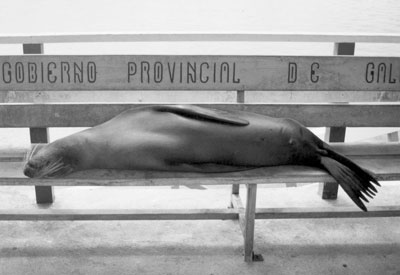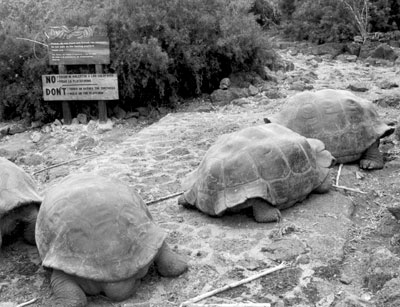Galápagos aboard Polaris
My wife, Elizabeth, and I took a cruise in the Galápagos Islands, Dec. 9-18, ’05, visiting on average one new (volcanic) island a day. The ship, Polaris, and all its personnel were provided by Lindblad Expeditions. Arrangements for the trip, however, were beautifully made by Carol Larsen of Betchart Expeditions (Cupertino, CA; 800/252-4910). She is simply a joy to deal with and totally effective as a tour director/expedition manager.
At a cost of $4,180 each, the tour included overnight stays at modern Hiltons both before and after the cruise, and a Category 2 cabin on Polaris. An additional $1,080 in airfare covered American Airlines flights (in economy) from Miami to Guayaquil and from Quito to Miami as well as the flights ($395) from Guayaquil to the islands and back to Quito. (On some trips, Lindblad provides a $500-per-person air credit.)
and their ability to get the information across to us.
The Galápagos Islands are now almost entirely an Ecuadorian national park (which, I discovered, also meant that I was not permitted to step a couple of feet off a path to get some shade!).
Because of their location, they have been a stopover of sailing ships for centuries, a place to obtain food for the long voyages ahead. The 650-pound tortoises seemed ideal for the purpose, and they were slaughtered by the tens of thousands until there were only 12 males and two females left when the Charles Darwin Research Station was established in the 20th century. To date, it has succeeded in breeding some 1,500 of these giants.
Since they know that people will not hurt them, all of the native animals seem unafraid of being harmed by visitors. Thus, sea lions, tortoises, iguanas, pelicans, flamingos and many others can be approached and photographed easily.
The Polaris, with a gross weight of 2,138 tons, was built in Aalborg, Denmark, in 1960 to serve as a ferry between Scandinavian ports. It was later bought by Lindblad Expeditions, was refurbished in Gothenburg, Sweden, in 1982 and now does this cruise 11 months of the year.
What is unusual is that 80 passengers are served by 51 crew, 13 officers and six staff — a total of 70 — which makes for very small cabins in our category but produces a wonderfully helpful and enjoyable atmosphere.
A handful of naturalists took turns as guides on the many daily Zodiac trips to various interesting places, making each trip more meaningful because of their profound knowledge
Snorkeling was a big hit for many of the passengers, but we abstained, never having done it before (which was required). Riding the Zodiac amidst schools of dolphins was an unexpected and exciting bonus. (Life jackets are compulsory while on the water.)
On the ship, the public rooms (dining and lounge) were lovely, with a capacity of 90 each. Our three meals a day were very good, and service was excellent. Seating was fluid and up to the passengers alone. In the evening, relevant PBS or “Nova” tapes alternated with live dance performances and talks.
Since the islands lie 600 miles off the Pacific coast of Ecuador, flights on local airlines were required. We were quite pleased with their punctuality, cleanliness and comfort.
HERBERT POPPER
Audubon, PA


